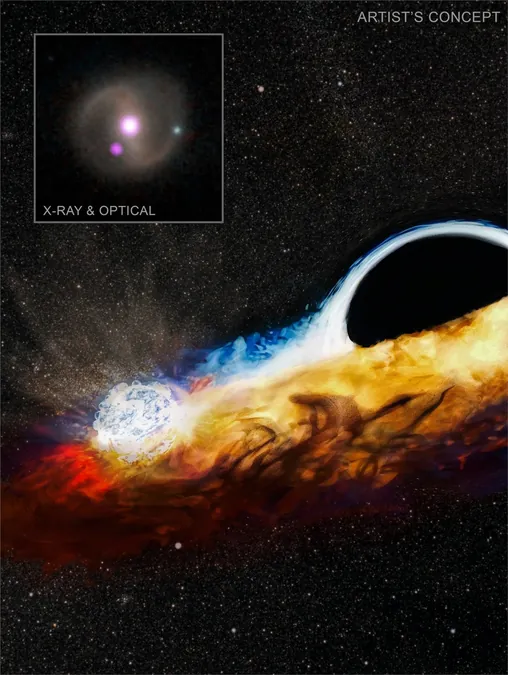
Supermassive Black Hole Gobbles Up Stars and Unleashes Cosmic Fury!
2024-10-10
Author: Nur
Groundbreaking Discovery
In a groundbreaking discovery, NASA's Chandra X-ray Observatory alongside several other telescopes has revealed the dramatic fate of a star devoured by a supermassive black hole. After tearing the star apart, this colossal entity is now using the remnants to unleash powerful bursts of radiation on another star or a smaller black hole. This remarkable research not only illuminates a dual cosmic mystery but also enhances our understanding of the hostile environments surrounding these giants of the universe.
Artist's Rendering of a Tidal Disruption Event
An artist's rendering showcases the aftermath of a tidal disruption event (TDE), where fierce tidal forces have shredded a star, creating a disk of debris illuminated in vivid reds, oranges, and yellows. Over several years, this disk expanded and intersected with another object—either a star or a smaller black hole—also caught in the gravitational grip of the supermassive black hole. Whenever this orbiting object impacts the disk, it triggers a surge of X-rays that Chandra detects, painting a vivid picture of this celestial drama.
Excitement from Astronomical Observations
The excitement began in 2019 when astronomers in California detected a brilliant flash of light that would later be identified as a tidal disruption event, dubbed AT2019qiz. Such events occur when stars venture too close to black holes, leading to their catastrophic disintegration under immense gravitational forces.
Quasi-Periodic Eruptions and their Link to TDEs
In parallel, scientists have been cataloging another intriguing phenomenon known as quasi-periodic eruptions (QPEs)—brief and explosive bursts of X-rays emitted near supermassive black holes. This study indicates a potential link between TDEs and QPEs, suggesting that these eruptions may occur when objects collide with the debris disk formed after a star's destruction.
Recent Investigations with Advanced Telescopes
In 2023, astronomers utilized both the Chandra and Hubble telescopes to investigate the aftermath of the TDE. Their observations revealed a weak signal in initial and final scans, but a stunning burst of activity in the middle observation period. Furthermore, data from NASA's Neutron Star Interior Composition Explorer (NICER) indicated that AT2019qiz erupts with astonishing regularity, approximately every 48 hours—a revelation confirmed by additional observations from NASA's Neil Gehrels Swift Observatory and India’s AstroSat telescope.
Collaborative Findings on Debris Disk Size
The collaboration of Hubble's ultraviolet data with Chandra's X-ray observations helped researchers determine the size of the debris disk. Astonishingly, if any object is in orbit around the black hole and completes its path within about a week, it could collide with the disk and trigger explosive eruptions.
Implications for Future Research
These groundbreaking findings are poised to enhance the search for more quasi-periodic eruptions linked to tidal disruptions, offering astronomers insights into the dynamics of cosmic violence around supermassive black holes. Discovering additional such events could significantly aid in understanding the populations and distances of stellar objects in precarious orbits around these formidable behemoths. This knowledge could even lead us to potential targets for upcoming gravitational wave observatories, opening new frontiers in our exploration of the cosmos.
Upcoming Publication
The paper detailing these astonishing findings will be published in the October 9, 2024, issue of the journal *Nature*. With the astute contributions of lead author Matt Nicholl from Queen's University Belfast, this research is set to catapult our understanding of the universe into uncharted territories.
Conclusion
Stay tuned as we continue to unravel the mystique surrounding these cosmic giants and their powerful, destructive forces!



 Brasil (PT)
Brasil (PT)
 Canada (EN)
Canada (EN)
 Chile (ES)
Chile (ES)
 España (ES)
España (ES)
 France (FR)
France (FR)
 Hong Kong (EN)
Hong Kong (EN)
 Italia (IT)
Italia (IT)
 日本 (JA)
日本 (JA)
 Magyarország (HU)
Magyarország (HU)
 Norge (NO)
Norge (NO)
 Polska (PL)
Polska (PL)
 Schweiz (DE)
Schweiz (DE)
 Singapore (EN)
Singapore (EN)
 Sverige (SV)
Sverige (SV)
 Suomi (FI)
Suomi (FI)
 Türkiye (TR)
Türkiye (TR)